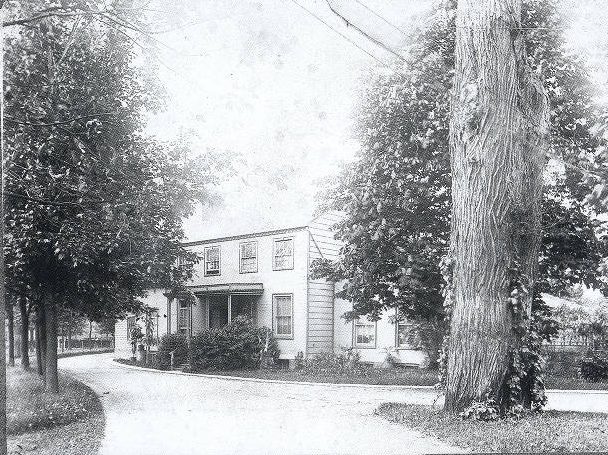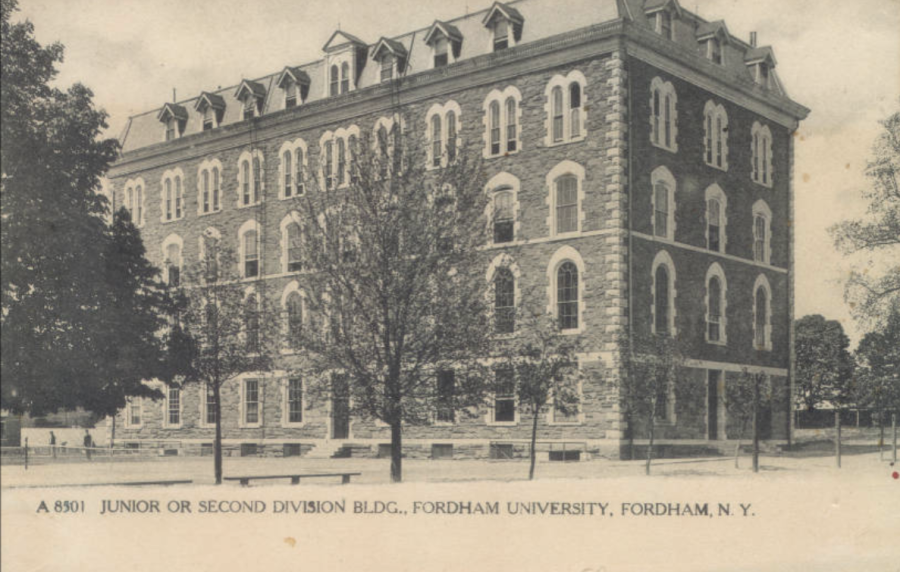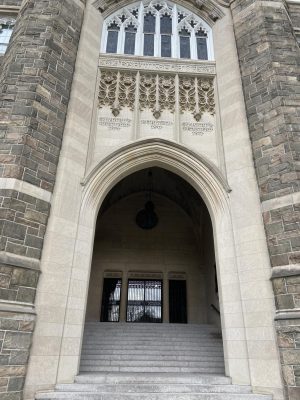Building the Bronx: The Lasting History of the Rose Hill Campus
The Rose Hill Manor holds remnants of history dating back to the American Revolution
COURTESY OF FORDHAM PHOTOGRAPH COLLECTION
John Hughes originally opened both a seminary and a college but the seminary is now the first-year residence St. John’s Hall.
April 27, 2022
Fordham Lincoln Center’s establishment in 1968 allowed for the process to be documented through pictures displayed across the campus’s walls. The Fordham Rose Hill campus, established over a century earlier in 1841, left few records of its founding, making the origins of the campus less familiar to current members of the Fordham community.
The campus’s namesake, Rose Hill Manor, was only one of two buildings on the Rose Hill property when John Hughes, coadjutor-bishop (later archbishop) of New York, acquired it in 1839.
Rose Hill Manor, previously known as Fordham Manor, had a rich history dating back to the American Revolution. Robert Watts named Rose Hill Manor after his family’s estate in Scotland when he acquired the property in 1787.
Allan Gilbert, a professor in the anthropology department at the Rose Hill campus, conducted extensive research into the university’s early years along with Roger Wines, a former professor of history. In 1985, they both received permission from Fordham’s 31st university president, the Rev. Joseph A. O’Hare, S.J., to excavate the foundation of Rose Hill Manor.
In their excavation, Gilbert and Wines found numerous artifacts, including patent medicine bottles, the college’s first set of dishes and rods of lead for writing on slate.
Gilbert and Wines also found minuscule traces of artifacts from Native American tribes. Gilbert noted that the only information on Native American settlement in the Fordham Rose Hill area arose after colonial contact, which described a Native American village located not far from Fordham near what is now Allerton Avenue.
He hypothesized that the pieces of these artifacts found in the Rose Hill Manor excavation could have been from rocks within the village that were used to fill in hollows and raise the land level. There is no way to be sure if these artifacts were in their original place.
Rose Hill Manor was built by Benjamin Corsa who grew up on a smaller farm on the property, according to Gilbert’s research. He eventually bought the land in the 1730s and subsequently built the manor in 1751, which was where he and his family resided until the American Revolution.

In the American Revolution, Rose Hill Manor played a vital role as a crossing point for the Continental Army. Corsa’s son, Isaac, served as a guide for then-General George Washington and Lieutenant General Rochambeau of France.
“Rose Hill Manor before it became the Rose Hill Manor, the house we excavated, had a certain fame to it; it was a substantial historical event that occurred at that time,” Gilbert said.
In 1838, a wealthy New York City Catholic named Andrew Carrigan bought the land for the sole purpose of selling it to Hughes.
Hughes acquired 100 acres of land in Fordham village for $29,750, which equates to around $800,000 today, and obtained Rose Hill Manor, as well as a stone building that survives as a central piece of the Cunniffe House. This amount of land is unattainable in 21st-century New York City, but at that time, the Bronx was not a part of the New York City we know and love today.
The Bronx borough, then known as Westchester County, was not connected to lower Manhattan and surrounding boroughs like it is today. The area was mostly farmland and was not nearly as crowded. Although the property value was low, Hughes had trouble raising enough money to purchase the 100 acres of land needed to establish his seminary and college.
“John Hughes believed passionately in the necessity of Catholic higher education.” Monsignor Thomas J. Shelley, former Fordham professor
Fordham’s original name was St. John’s College, in honor of Hughes’ patron saint. The name was changed to Fordham University in 1907, after the university expanded into graduate schools of medicine and law.
Monsignor Thomas J. Shelley described the financial difficulties Hughes faced while starting St. John’s College in his book “Fordham: A History of the Jesuit University of New York.” These financial difficulties were indicative of the New York Catholic community’s poverty in 1841.
As an Irish immigrant, Hughes’ goal was to establish a college that would educate Catholic immigrants who suffered discrimination and could not receive a public school education.
“John Hughes believed passionately in the necessity of Catholic higher education,” Shelley said.
Hughes’ vision for St. John’s College was to have both a seminary and college. However, after opening the St. Joseph Seminary in 1840, a lack of funds forced him to delay the college’s opening for another year.
The founding of the college suffered many challenges with finances, employment and bigotry. Hughes wanted to transform his college with the help of French Jesuits who were managing a small college in rural Kentucky. At the same time, the Jesuits were looking to move to a metropolitan area. Hughes subsequently sold St. John’s College to the Jesuits while maintaining control over his seminary.
A few decades later, the construction of the Harlem Railroad led to population growth within Fordham Village, as the railroad ran from downtown Manhattan to the university in an hour.
The university’s growing accessibility from the surrounding New York City area enabled the Jesuits at Fordham to revitalize and expand the college.
According to Rev. Robert R. Grimes, S.J. and former dean of Fordham College at Lincoln Center, the Rose Hill commencement ceremony at Fordham drew crowds as it became the prime source of entertainment for the night. The university’s growing accessibility from the surrounding New York City area enabled the Jesuits at Fordham to revitalize and expand the college, primarily through the development of a more extensive faculty.
Although new academic buildings, residence halls and the Walsh Library would transform the Rose Hill campus over the next century, the campus had the chance to be even bigger than we know it today.
When the Jesuits arrived, the Rose Hill campus extended from as far east as the Bronx River to Webster Avenue. New York City then acquired about 26 acres of the property for $9,300 by eminent domain, which outlines the government’s power to acquire private property for public use provided that they compensate the owner with the fair market value price. This land is now known as the New York Botanical Garden.
While the Jesuits had taken control of the college’s educational, financial and daily practices, Hughes still had the authority over St. Joseph’s Seminary, which was connected to St. John’s College and still remains a part of Fordham. This relationship caused friction between Hughes and the Jesuits, as he believed that the Jesuits were neglecting the seminary.
The land still holds pieces of the past, with some of its history still present in the architecture.
According to Shelley, there were repeated complaints about the poor living conditions in the seminary.
After several conflicts with the Jesuits, Hughes moved his seminary upstate. Eventually, St. Joseph’s Seminary became St. John’s Hall, which now serves as a first-year residence hall in Queen’s Court. The land still holds pieces of the past, with some of its history still present in the architecture.
“If you look at the sidewalk that runs between St. John’s and the church, you will notice that a little passageway that allowed passage from St. John’s into the church has been removed, and the openings in the walls have been bricked up,” Gilbert said.
While the Jesuits transformed the Rose Hill campus into what we know today, according to Shelley, it was the choices Hughes made that allowed for the creation of Fordham University.













